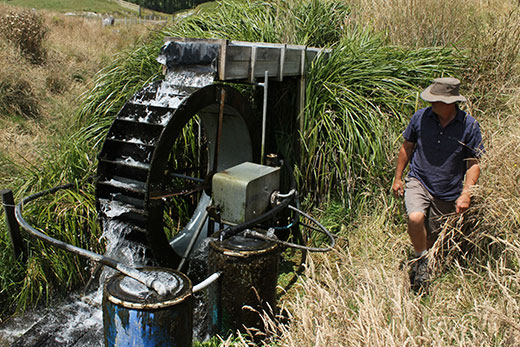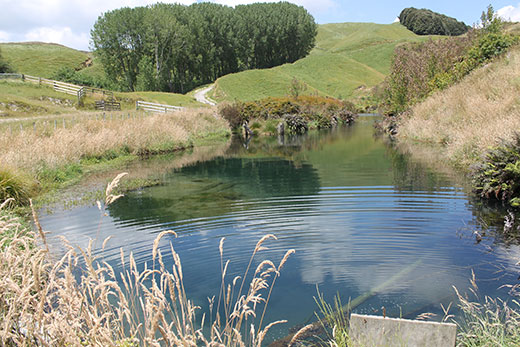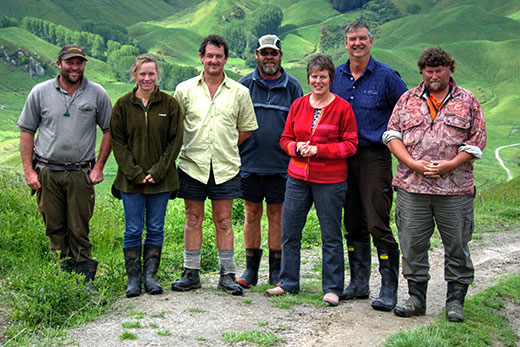Volcanic action “cleared” much of the forest, shaped the land and continues to influence how Highlands Station is farmed.
Understanding those forces and how to work with them is vital to the success of one of the largest farms in the Rotorua district.

Catherine and John Ford erected this plaque in honour of Allen Ford, who began developing Highlands Station in 1932.
Distinctive ‘rills’
The eruption also coated the hills with ash and heavy rains, which followed created distinctive “rills” like large vertical corrugations, down the faces of the hills.
Allen left most of the surviving bush standing but extracted rimu, using bullocks to pay for farm development.
Today 320 hectares of bush are protected under Queen Elizabeth II, regional council and private covenants and 18km of fencing has been constructed to keep stock out.
Tarawera had the most dramatic recent impact on the land, but its volcanic history goes back much further.
The farm stands on an old rhyolite dome formed about 250,000 years ago and John can read its history in the layers exposed in cuttings alongside farms tracks.
Rotomahana mud can be up to two metres deep in places. The kaharoa ash is drier but lacking in minerals, and underneath is Taupo pumice.
The mud soils are high in phosphate and to reduce phosphate loss John has constructed a series of up to 200 detention dams throughout the farm, which slow the run-off and collect sediments.
On August 20, 2014, the dams were thoroughly tested by the biggest rainfall in 10 years.
The dams held the water in the upper catchments and in places no water flowed out, showing how effective the dams are in retaining water and reducing sediment loss.

A water wheel pumps water to tanks from where it’s gravity fed to troughs on more remote parts of Highlands Station.
Lake catchments
The farm is in the catchments of both Lakes Tarawera and Rotokakahi (Green Lake) and Catherine and John, who eventually purchased the farm from John’s siblings in 1995, take this into account within their farm management practices.
This has included a move away from cows to raising beef bulls and steers, and breeding ewes.
Properly managed, says John, the bulls have less impact on the land and nitrogen leaching. The young stock arrives in November and is sold after 15 months.
Many farmers are turning away from raising bulls to taking on dairy grazers because bulls are perceived as hard work.
“However, if you manage them and understand their nature, they’re not; and the financial rewards are greater.”
Highlands Station bulls – Catherine likens to unruly teenagers – are managed by keeping them in relatively small groups, giving them room to get away from each other and feeding them well.

Waterways on Highlands Station have been fence to exclude stock and this one feeds a water wheel, which pumps water to tanks which in turn gravity feed farm troughs.
Stock numbers
Sheep perform well at Highlands Station too. Romney genetics have been introduced to improve facial eczema resistance and robustness.
No supplements are fed out or made on-farm. Stock numbers are carefully linked to the available pasture and John doesn’t hesitate to reduce numbers if he thinks a drought is looming.
Highland Station’s meat and wool production put it among the top five per cent of New Zealand drystock farms.
Despite its steep nature, there’s no erosion on the hills thanks to careful grazing management.
In all, the farm covers 1240ha, of which 992ha are effective. Managing a property of this size takes planning and requires good infrastructure.
This includes 17km of tracks to maintain, strategically placed yards, the use of solar-powered electric fencing in remote parts of the farm and a water wheel which pumps water to tanks from where it’s gravity fed to troughs.
Highlands Station’s staff are actively involved in the farm’s management and decision-making with each responsible for a different part of the farm and mobs of stock, creating a healthy competition to reach growth rates.
“The success of Highlands Station is due to our staff,” says Catherine. “We are the owners and take the financial risk but our staff produce the results which make it viable.
“At least the last 10 per cent or more of stock production and performance comes from staff decisions and knowledge.”



0 Comments
Leave a Comment